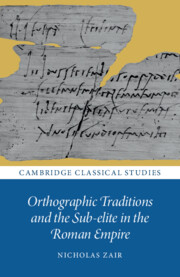In the second half of the second century BC, the Romans adopted the practice of writing long vowels with double letters from the Oscan alphabet (Reference OliverOliver 1966: 151–5; Reference VineVine 1993: 267–86; Reference Wallace and ClacksonWallace 2011: 18; Reference WeissWeiss 2020: 32). However, it did not remain a standard part of Latin orthography past the end of the Republic. According to Oliver, Wallace and Weiss, the double spelling of long vowels can be found as late as the early fourth century AD. Oliver points out uii (CIL 3.4121) = uī ‘by force’ from AD 312–323,Footnote 1 exercituus (CIL 6.230) for exercitūs ‘of the army’, from AD 222–235, and aara (Reference LemerleLemerle 1937 no. 12) for ārās,Footnote 2 fourth century according to Oliver, third century according to Lemerle.
It is difficult to find really plausible examples for the first to fourth centuries AD, partly because the possibility of false positives when searching the EDCS is very high, and partly because it is hard to be sure that a particular instance is not a mistake in the writing. Searches for <aa>, <ee>, <oo> and <uu> provide a small number of at all plausible examples:Footnote 3 Spees (CIL 4.5127, prior to AD 79), [I]uunia (CIL 4.8029, prior to AD 79), lacuus (CIL 12.2606, 2607, first century AD), domuus (CIL 9.4794; first century AD, Reference DessauDessau 1892–1916, 7332), Iuulius (AE 1976.700, AD 201), porticuus (ILA 531, AD 298), Ianuariaas (CIL 11.4033, AD 345, but note a mistake in palcis for pacis), Erclaanius (ICUR 10.26742 = EDB18026, AD 301–349), uoot(a) (AE 1977.540), feceerunt (AE 1972.709), dieebus (CIL 14.1212), duouiratuus (CIL 3.9768).
The writers on language who mention this feature at all consider it old-fashioned. Quintilian mentions it in passing:
at, quae ut uocales iunguntur, aut unam longam faciunt, ut ueteres scripserunt, qui geminatione earum uelut apice utebantur …
When letters which are vowels are joined together, they either make one long vowel, as the ancients wrote, who used this gemination as though it were an apex …
usque ad Accium et ultra porrectas syllabas geminis, ut dixi, uocalibus scripserunt.
Down to the time of Accius and beyond they [i.e. ‘the ancients’] wrote long syllables with double vowels, as I have mentioned.
Unsurprisingly, therefore, use of double letters to write long vowels in the corpora is extremely rare, if not non-existent. The curse tablets provide two possible examples: uoos for uōs ‘you’ (Kropp 11.1.1/26) from Carthage, dated to the second century AD, and ceernis (Kropp 6.1/1) for cernis, from Noricum, mid-second century AD. In neither case can a mere dittography be ruled out. In the case of 6.1/1, additional letters are also written in siuem for sīue (due to anticipation of the following word Iouem?), oporno/tet for oportet and quom/modi for quōmodo (dittography across a line divide). It seems unlikely that ceernis is an intentional use of double letters. In 11.1.1/26 uos is written thus several more times, and no other long vowel is written with double vowels. We also find in this tablet the old-fashioned spelling iodicauerunt for iūdicāuē̆runt (see p. 74). The spelling on this tablet is substandard, but mostly reflects the spoken language. However, there is an unmotivated geminate spelling in coggens for cōgēns ‘forcing’, and a scrambled spelling in Atsurio for Asturiō. I do not think we can be sure that uoos reflects an old-fashioned spelling rather than an accidental dittography.
In addition, we find an instance of q̣uụr (Tab. Vindol. 652) for cūr at Vindolanda between AD 104 and 120. However, while a possible analysis here is that <q> represents /k/ before /u/ and that <uu> represents /uː/, it is more likely that this is a quasi-etymological spelling whereby /qu/ represents *kw (cf. the spellings quom and quum for cum; pp. 165–8). In the Vindonissa tablets, we have the dative Secundi{i}na<e> (T. Vindon. 41). Again, dittography seems more likely than intentional double writing of the vowel.



